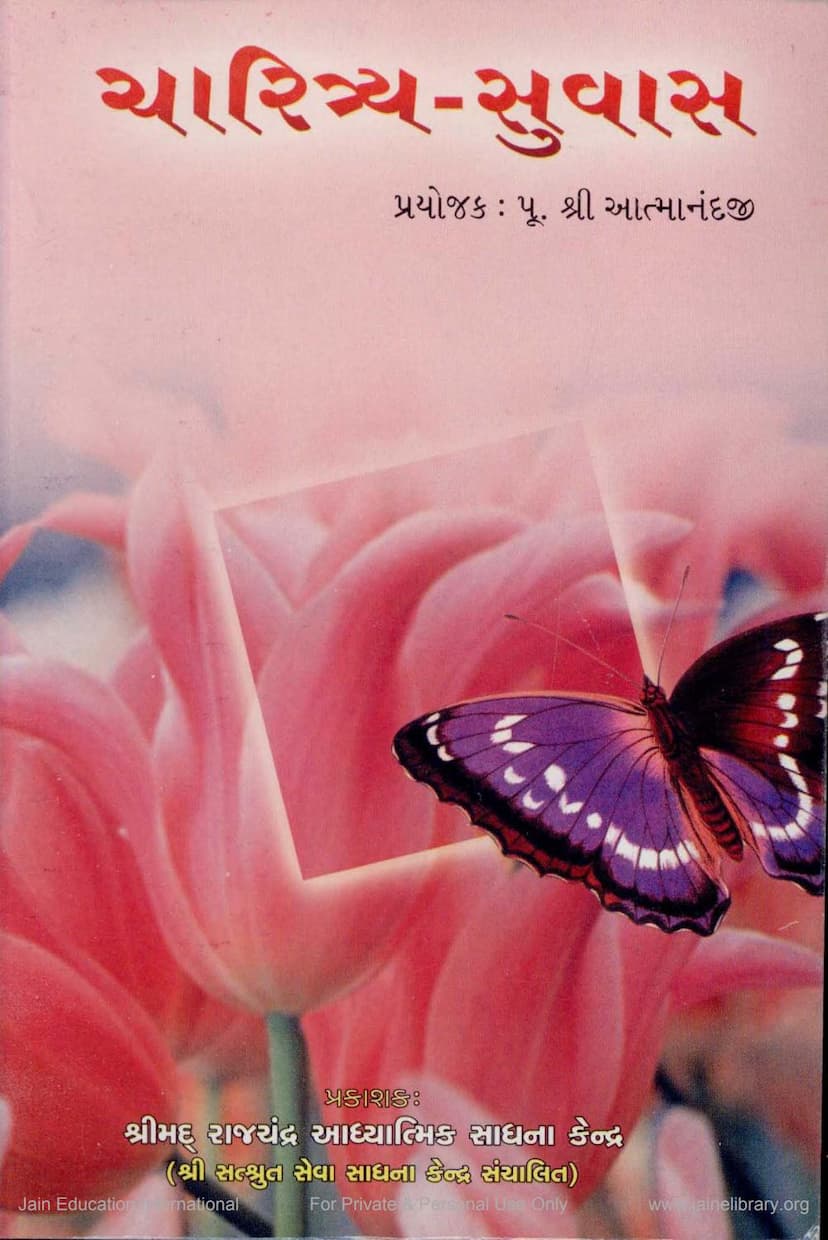Charitrya Suvas
Added to library: September 1, 2025

Summary
Here is a comprehensive summary of the Jain text "Charitrya Suvas" by Atmanandji Maharaj, based on the provided pages:
Book Title: Charitrya Suvas (The Fragrance of Character) Author/Editor: Pujya Shri Atmanandji Maharaj Publisher: Shrimad Rajchandra Adhyatmik Sadhana Kendra, Koba (Gujarat, India)
Overall Purpose and Theme:
"Charitrya Suvas" is a collection of inspiring anecdotes and stories designed to cultivate virtuous character. The book aims to guide individuals, especially the youth, towards a noble and ideal way of living by presenting real-life examples of great personalities from various walks of life and across different historical periods. The central theme is the importance of adhering to ethical principles, moral conduct, and spiritual values as demonstrated by these exemplary individuals. The book emphasizes that true happiness and fulfillment are found in the practice of virtues like truthfulness, non-violence, honesty, compassion, contentment, and self-control.
Key Aspects and Content:
-
Inspirational Narratives: The book is comprised of short, impactful stories, each illustrating a specific virtue or positive trait. These narratives are drawn from historical events, the lives of saints, kings, scholars, artists, and even ordinary individuals who displayed extraordinary character.
-
Focus on Character Development: The primary goal is to provide inspiration and practical guidance for character building. By showcasing how individuals navigated challenges and upheld their values, the book encourages readers to emulate these qualities in their own lives.
-
Diverse Examples: The stories feature a wide range of individuals, from kings and ministers to poets, artists, merchants, and even those considered morally flawed who ultimately reformed. This diversity ensures that readers from all strata of society can find relatable and inspiring examples.
-
Emphasis on Jain Principles and Universal Virtues: While rooted in Jain philosophy and the teachings of Shrimad Rajchandra, the book also highlights universal virtues that are beneficial to all of humanity. Concepts like non-violence (Ahimsa), truthfulness (Satya), honesty (Pramanikta), compassion (Daya), contentment (Santosh), forgiveness (Kshama), self-control (Sanyam), and devotion (Bhakti) are prominently featured.
-
Historical and Realistic Approach: The introduction (Aamukh) states that the stories are presented from a historical and realistic perspective, avoiding purely mythological elements. The aim is to present "living and breathing incidents" that are believable and impactful.
-
Target Audience: The book is particularly aimed at students and the younger generation, recognizing their formative years as crucial for character development. However, its universal message makes it valuable for readers of all ages.
-
Structure and Content Highlights (from the Index and sample pages): The book features numerous stories, each with a distinct moral or virtue. Some prominent examples include:
- Ahimsa ka Pujari (Worshipper of Non-violence): Illustrates unwavering commitment to non-violence even in the face of authority.
- Pramanikta ka Pratap (The Glory of Honesty): Shows how honesty can bring about divine intervention and societal respect.
- Amarpadprapti ka Rasayan (The Elixir of Immortality): Highlights the importance of solitude and meditation for spiritual attainment.
- Khuda ka Firista (Angel of God): Features Shrimad Rajchandra's extraordinary honesty and sacrifice.
- Daridranarayan ke Prati Prem (Love for the Poor): Demonstrates compassion towards the needy, exemplified by St. Francis.
- Putra ke Lakshan Parana se (A Child's Traits are Known from the Cradle): Shows early signs of compassion and spiritual inclination in a child who becomes a great saint.
- Saachaa Tyagi aur Daneswari (True Renunciate and Generous Giver): Depicts selflessness and sacrifice for the well-being of others.
- Apashabdo Kyan Jaay? (Where Do Abusive Words Go?): Illustrates the power of non-retaliation and absorbing negativity.
- Aadarsh Vartana ka Prabhav (The Impact of Ideal Conduct): Shows how virtuous behavior can transform a thief.
- Vidya ka Abhiman (Pride of Knowledge): Warns against the arrogance that comes with learning.
- Kalaakar ki Udhaarta (Generosity of an Artist): Highlights the importance of supporting emerging talent.
- Nishpakshata (Impartiality): Demonstrates fairness in judgment, even with family.
- Thapan Jaldi Pachi Aapi De (Return the Deposit Promptly): Emphasizes trust and promptness in returning borrowed items.
- Satya ki Prastuti (Presentation of Truth): Encourages admitting one's mistakes.
- Anukaran (Imitation): Warns against blindly imitating everything a guru does, distinguishing between good and bad conduct.
- Satya Paalan (Adherence to Truth): Stories of individuals upholding their promises.
- Namarata ka Adarsh (The Ideal of Humility): Shows humility in the face of praise.
- Krutagnata (Gratitude): Illustrates the virtue of thankfulness.
- Kshama ka Prabhav (The Influence of Forgiveness): Demonstrates the power of forgiving others.
- Sanyam se Siddhi (Achievement through Restraint): Highlights how self-control leads to success.
- Shurvirta ka Sanman (Respect for Bravery): Shows admiration for courage.
- Adarsh Rajvi (Ideal Ruler): Exemplifies responsible governance and care for subjects.
- Matrubhakti (Mother's Devotion): Highlights the supreme importance of maternal respect.
- Vachan ka Palan (Keeping One's Word): Stories of unwavering commitment to promises.
-
Call to Action: The book concludes with a fervent hope that readers will not just be content with reading these stories but will internalize the virtues and actively practice them, thereby ennobling their own lives and honoring their ancestral heritage.
In essence, "Charitrya Suvas" serves as a guide to living a life of meaning and purpose by drawing wisdom from the lives of those who exemplified the highest human values, encouraging readers to cultivate a rich and fragrant character.